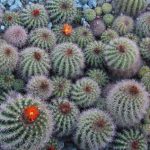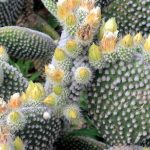In the US, prickly pear plants are familiar sights cherished for their delectable edible pads and fruit. Dive into the world of growing these cacti with our expert tips!
Discover the intriguing genus of prickly pear plants known as Opuntia spp., hailed for their culinary and aesthetic value across the southwestern US and Mexico. One species even plays a vital role in Mexico’s national narrative as depicted on the country’s flag.
These plants’ striking pads and vibrant fruit not only add visual appeal to gardens but also offer valuable nutrients. Their resilience and simplicity in cultivation make them a favored choice among gardeners. However, it’s vital to bear in mind that under favorable conditions, prickly pears can rapidly propagate and form dense colonies.
Opuntia encompasses a diverse array of species, each with unique growth requirements and habitats. Nonetheless, most varieties thrive in full sun and well-drained soil, making them a delightful addition to diverse garden landscapes.
Essential Care Guidelines
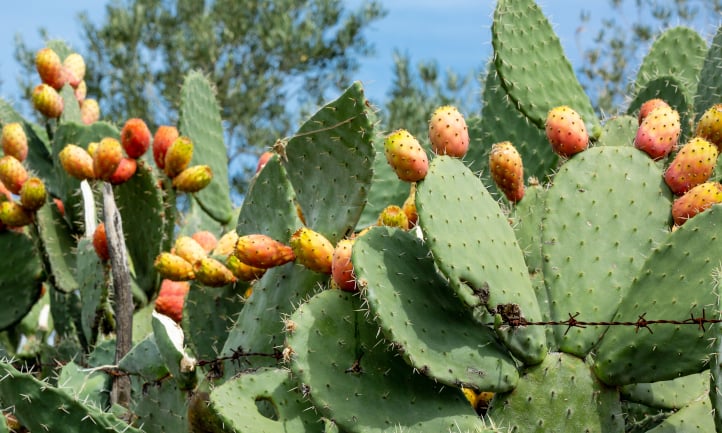

| Common Name(s) | Prickly pear, jointed cactus, Indian fig, barbary fig, eastern prickly pear, bunny ears cactus, nopal, tuna fruit, tiger pear |
| Scientific Name | Opuntia spp. |
| Days to Harvest | Varies by species, with some requiring years to yield cactus fruit. |
| Light | Full sun |
| Water | Water every 10-14 days, ensuring soil dryness between watering sessions. |
| Soil | Opt for well-draining sandy to gravelly soil. |
| Fertilizer | Outdoor plants typically require no additional fertilization. Indoor plants may benefit from balanced fertilizer. Consider using nitrogen-rich fertilizer to boost pad growth or low-nitrogen variants for enhanced flowering and fruiting. |
| Pests | Potential pests include cochineal scale, cactus longhorn beetle, cactus moths, and cactus bugs. |
| Diseases | Watch out for Phyllosticta pad spot and Opuntia Sammon’s virus. |
Comprehensive Insights on Prickly Pear Plants
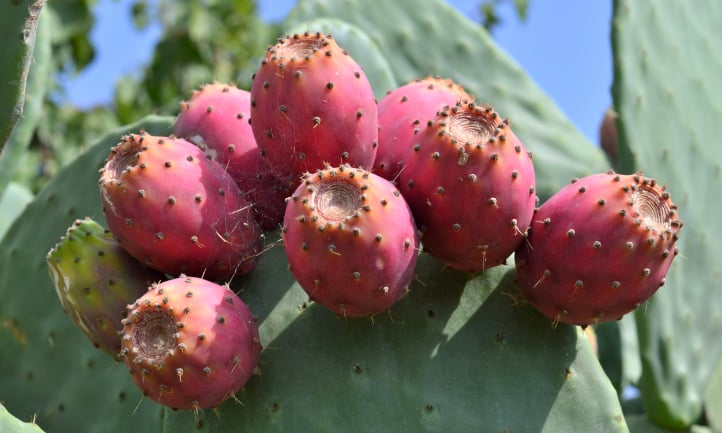

Uncover the fascinating world of prickly pears, characterized by their distinct Opuntia and Platyopuntia subgenus, known for the stacked fleshy pads that redefine the cactus family. These pads, adorned with spines and typically sporting shades of green to blue, continuously develop, creating a uniquely structured plant.
Among the array of varieties, the O. santa rita stands out with its vivid violet hue. Commonly referred to as paddle cactus or jointed cactus, these plants are further distinguished by their eye-catching pink, orange, red, or yellow blossoms, blooming during spring or summer under suitable conditions.
These blooms eventually give rise to edible, pear-shaped fruits known as cactus pears or tuna fruit, boasting a spectrum of colors such as green, yellow, red, or purple, depending on environmental cues. Prickly pear plants have evolved to thrive in arid environments, equipping themselves with extensive, water-maximizing root systems and unique carbon fixation mechanisms for optimal survival.
Propagating through both vegetative means and animal-assisted seed dispersal, new prickly pear plants sprout year-round, demanding minimal upkeep once established. With species originating from various regions including the American southwest, Mexico, and beyond, it’s crucial to note the federally classified noxious weed, O. aurantiaca, among the diverse Opuntia group.
Prized for their highly nutritious pads and fruits, prickly pear plants offer versatile culinary uses, ranging from pickling nopales to crafting jams, jellies, wines, and natural dyes with their fruits. Beyond the kitchen, these plants find applications in livestock feed and traditional dye production, bearing both aesthetic and practical significance.
Exploring Prickly Pear Varieties
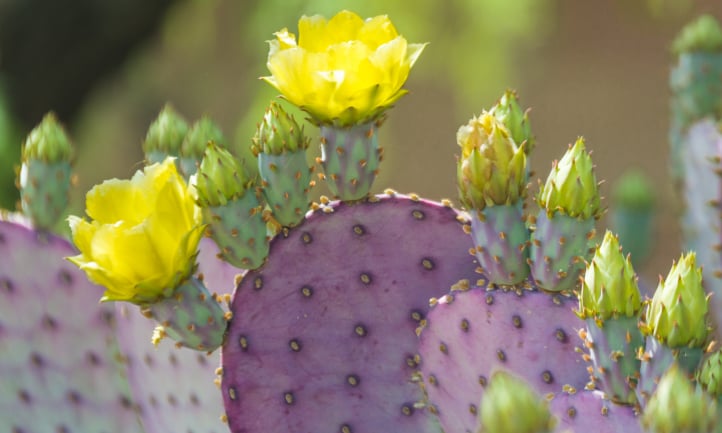

Prickly pear variations are abundant within the extensive Opuntia family, consisting of nearly 60 species. Explore some common types below:
Opuntia ficus indica, often referred to as the Indian fig or barbary fig, originates from Mexico and Central America. Widely grown worldwide for its sweet, edible fruits, this species thrives in harsh soil and high-temperature environments.
Opuntia humifusa, known as the eastern prickly pear cactus, sprawls across the Eastern U.S. and Canada. With small round pads and vibrant pink or yellow flowers, this species can endure cold climates and can even be found as far north as Ontario.
A staple in Native American diets, Opuntia humifusa not only serves as a food source but also offers medicinal properties. Despite withering in winter, it regains its vivid blue-green hue come early spring.
Opuntia microdasys, the angel’s wings or bunny ears cactus, showcases clusters of sharp yellow glochids. Originating from northern Mexico and the Southwestern U.S., this species requires protection from frost and is often kept as a houseplant.
Other notable Opuntia varieties include beavertail cactus (Opuntia basilaris), violet prickly pear (Opuntia santa-rita), pancake prickly pear (Opuntia chlorotica), giant prickly pear (Opuntia streptacantha), Texas prickly pear (Opuntia engelmannii), and coastal prickly pear (Opuntia littoralis).
Under favorable perennial conditions, prickly pear cacti can grow up to 12 feet tall and 4 feet wide, with some species boasting pads reaching up to 6 inches in length and towering up to 20 feet.
Planting Prickly Pear Cactus
Enhance your garden or home with the captivating presence of prickly pear cactus. The ideal planting time is during warm months when the soil is toasty and sunlight abundant.
To prevent rot, plant young prickly pear pads at a depth of ½ to ¾ inches, ensuring they stand tall. Opt for well-draining soil and full sun, as these cacti thrive in arid conditions and various soils.
Whether in the ground or containers, proper drainage is crucial. While seed propagation is possible, it’s slow. Rooting cuttings is a more efficient method to expand your prickly pear collection.
Prickly Pear Plant Care


Managing prickly pear cactus requires a delicate balance of light, water, and nutrients to promote fruiting. Avoid overwatering, a common pitfall in caring for these plants.
Sun and Temperature
These cacti thrive under full sun exposure, adapting well to arid conditions. While most varieties can’t withstand cold, some species can thrive in cooler climates down to zone 3b.
Water and Humidity
As desert denizens, prickly pears excel in dry environments. Water every 10-14 days or when the soil is dry 2-3 inches deep. Avoid watering in damp conditions and reduce irrigation during winter months.
Diminished nighttime temperatures below 60°F signal a halt to watering. These water-efficient ornamentals require minimal humidity, best achieved through targeted, base-level irrigation.
Soil
Prickly pear cacti thrive in well-draining soil, with no specific pH preference. Opt for a cactus potting mix for indoor plants or sandy, rocky soil for outdoor growth.
Fertilizing Prickly Pear Cactus
Though typically not heavy feeders, nitrogen-based fertilizer can boost pad yields. For abundant flowers and fruits, utilize a low-nitrogen or 0-10-0 NPK option monthly. Indoor plants benefit from balanced fertilization due to faster nutrient depletion.
Pruning Prickly Pear Cactus
Pruning is mainly for control, propagation, or disease management. Address any pathogens promptly to safeguard your prickly pears from potential spread, particularly via sporulation.
Prickly Pear Cactus Propagation
Exploring the propagation of prickly pear cactus unveils fascinating methods including cuttings, seeds, and grafting, each with its unique approach. The most widely practiced technique involves pad cuttings where the lower parts of the plant are preferred due to their susceptibility to disease in high humidity. Implement proper tool sanitation by using rubbing alcohol. Once a healthy pad is snipped from a mature plant, allow it to dry before planting it cut-side down in soil. Adequate watering will aid quick rooting in just a few days, stimulating the growth of new pads from the cutting’s margins.
An alternative approach involves utilizing seeds, although their germination rate may be inconsistent. To enhance seed germination, scrub off any fruit pulp clinging to the seed, scarify the hard outer coat, soak the seeds, and plant them shallowly in the soil. For a comprehensive guide on cutting and seed cultivation for prickly pear cactus propagation, refer to the resources available at Epic Gardening.
Alternatively, commercial growers may opt for grafting as a sophisticated propagation method. This advanced technique aims to foster specific growth habits, enhance flower production, or bolster the plant’s resilience by merging it with robust root stock. While grafting is not commonly practiced by home gardeners due to its intricate nature and time-consuming process, it remains an essential method in the commercial cultivation of prickly pear cacti.
Harvesting and Storing Prickly Pear Cactus


Harvesting prickly pear cacti entails a cautious approach to protect oneself from spines and glochids when collecting both the fleshy pads and fruits. Avoid washing them until all spines and glochids have been meticulously removed, as even spineless varieties can cause irritation due to tiny glochids present.
Harvesting
To ensure optimal ripeness, prickly pear fruits should be harvested when fully mature as they do not ripen post-harvest. In North America, the prime harvest season typically spans from August to September. Employ tongs and gloves during harvesting, testing for ripeness by gently squeezing the fruits to check for pliability. Ripe fruits will detach easily with a slight squeeze impression, with size and color serving as less reliable indicators of maturity in different varieties.
To safely detach ripe fruits, twist them with tongs to avoid glochid-induced irritation. As glochids can be sharp and resilient, employ a lighter to singe the fruit’s exterior and subsequently rinse under water. The charred surface aids in removing glochids for easier handling. Moreover, when harvesting pads, use tongs and gloves to carefully sever them from the plant. Opt for younger pads for a tender texture, ensuring thorough spine removal before peeling to access the flesh, ideal for culinary purposes or commercial cultivation.
Storing
Storing prickly pear fruits for short durations can be achieved in the refrigerator, while frozen fruits serve as a precursor for juicing or long-term storage. Prickly pear juice, preserved in the freezer, boasts a shelf life of up to a year, offering versatile applications in concocting jelly, jams, and even alcoholic beverages. For non-juicing purposes, peel, deseed, and slice the fruits into chunks for freezing, ensuring a single-layer freezing on trays before transferring into storage bags for extended preservation.
Pad storage presents challenges owing to their high water content, prone to rapid deterioration in refrigeration. Conventional freezing or pressure canning methods can alter the flesh texture, rendering them mushy. To circumvent this, explore pickling or dehydrating techniques, utilizing ovens or dehydrators to achieve optimal preservation results for extended shelf life of prickly pear cacti.
Troubleshooting
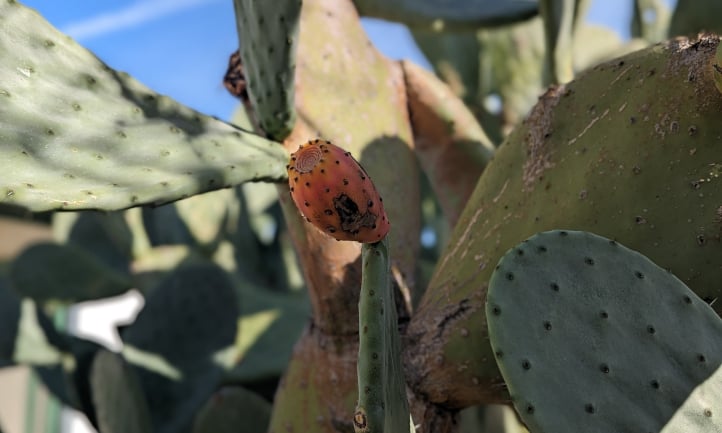

Troubleshooting potential issues encountered with the growth of prickly pear involves attentive observation and targeted solutions to address growing conditions, pest infestations, or disease outbreaks that may hinder plant vitality and productivity.
Growing Problems
Diligence is crucial in avoiding common growing problems such as overwatering, which can lead to root rot in persistently damp soil. To prevent this, allow the soil to dry between watering cycles and ensure shallow planting of cuttings to minimize the risk of root rot. Adequate soil drainage is essential in mitigating these risks, as poor drainage exacerbates root rot potential. Conversely, underwatering poses a detrimental threat, particularly evident in houseplants displaying wilting, yellowing, and browning symptoms culminating in plant demise due to prolonged water deprivation.
Adverse weather patterns and climatic fluctuations may also pose challenges not just for prickly pear cactus
Issues related to growth can arise for desert plants, even if they were originally cultivated in controlled environments like greenhouses and nurseries, leading to potential sunscald problems. Sunburn on cacti appears as large tan patches that can eventually scar the plant.
To prevent sunburn on cacti bought from greenhouses for outdoor landscaping, acclimatize them gradually by exposing them to a few hours of sunlight daily. Planting in late winter may also be beneficial due to the less intense solar rays during that time.
Inadequate protection from frost and freeze can harm non-cold-tolerant cactus species. Selecting suitable species for the local climate and using covers like floating row covers or cotton sheets during unexpected cold spells can safeguard the plants. Container-grown plants can be brought indoors until the weather improves.
Hail can also inflict damage on prickly pear plants, but protective measures such as those against frost can be effective in minimizing the impact.
Pests
Despite their thorny defense system, prickly pear cacti are susceptible to certain insects. One such pest is the Cochineal scale, which can be identified by its mealybug-like appearance and white, waxy outer coating. Crushing the insect reveals deep red body fluids. Another common intruder is the cactus longhorn beetle, recognized by its shiny black hue and tendency to feed on cacti. Early morning and evening inspections can help in handpicking these pests off affected plants.
During extended drought periods, small animals may nibble on cacti for water access. Generally, these plants can recover from minor nibbling without the need for additional intervention.
Some insects serve as biological control agents to restrain the invasion of cacti species. The cactus moth, utilized in Australia, has demonstrated effectiveness by burrowing into cactus pads and consuming their flesh from within.
Diseases
While prickly pears are robust plants with minimal disease susceptibility, two notable ailments to watch for are Phyllosticta pad spot and Sammons’ virus. The former, caused by a fungal pathogen, can be managed by keeping pads dry and removing infected areas. The latter, a virus akin to the Tobacco Mosaic Virus, exhibits yellow rings on pad tips, with no significant impact on plant health.
Frequently Asked Questions
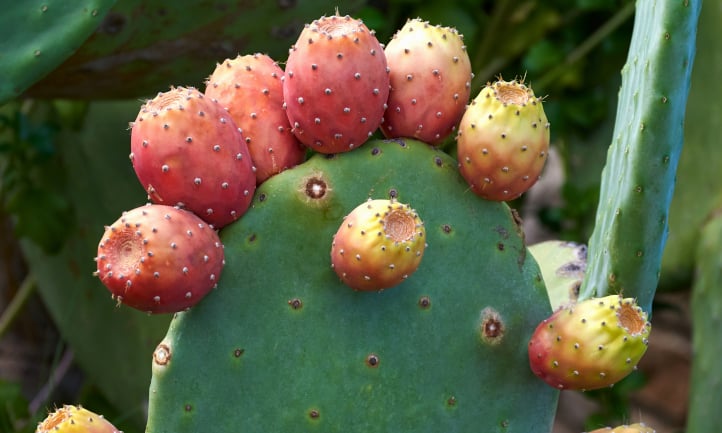

Here are some frequently asked questions about growing and managing prickly pear cacti:
Q: Where does prickly pear grow best?
A: Prickly pear plants thrive in sunny locations with sandy to gravelly soil, typically found in arid to semi-arid landscapes.
Q: How fast does prickly pear grow?
A: Under favorable conditions, prickly pears can quickly propagate and form dense colonies, sometimes outcompeting other native species during drought years.
Q: Why are prickly pears a problem?
A: Uncontrolled spread of prickly pears in the wild, particularly in Australia, poses challenges. Some species are classified as noxious weeds in the U.S., managed through methods like scheduled burning.
Q: Are prickly pears easy to grow?
A: Yes, once established, prickly pears are easy to maintain.
Q: Can you touch prickly pear?
A: Avoid direct contact due to their detachable spines and irritating hairs. Use gloves and tongs when handling prickly pear plants.
Q: What month do prickly pears bloom?
A: Bloom times vary by variety and location, typically occurring from late spring to late summer.
Q: What is the lifespan of a prickly pear cactus?
A: Depending on the species, prickly pears can live long lives under suitable conditions. For example, Opuntia ficus-indica can reach up to 80 years.
Q: Can you eat a prickly pear fruit raw?
A: Raw prickly pear fruit is edible and can also be juiced or used as a natural dye, with the O. ficus-indica variety being popular for consumption.

